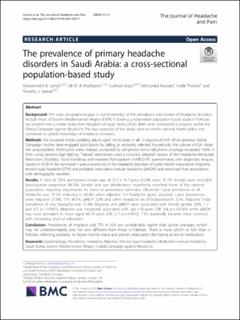| dc.description.abstract | Background
The large geographical gaps in our knowledge of the prevalence and burden of headache disorders include most of Eastern Mediterranean Region (EMR). Following a nationwide population-based study in Pakistan, we present here a similar study from Kingdom of Saudi Arabia (KSA). Both were conducted as projects within the Global Campaign against Headache The two purposes of this study were to inform national health policy and contribute to global knowledge of headache disorders.
Methods
We surveyed Arabic-speaking adults aged 18–65 years in all 13 regions of KSA. While previous Global Campaign studies have engaged participants by calling at randomly selected households, the culture of KSA made this unacceptable. Participants were, instead, contacted by cell-phone (since cell-phone coverage exceeded 100% in KSA), using random-digit dialling. Trained interviewers used a culturally adapted version of the Headache-Attributed Restriction, Disability, Social Handicap and Impaired Participation (HARDSHIP) questionnaire, with diagnostic enquiry based on ICHD-II. We estimated 1-year prevalences of the headache disorders of public-health importance (migraine, tension-type headache [TTH] and probable medication-overuse headache [pMOH]) and examined their associations with demographic variables.
Results
A total of 2316 participants (mean age of 32.2 ± 10.7 years; 62.3% male; 37.7% female) were included (participation proportion 86.5%). Gender and age distributions imperfectly matched those of the national population, requiring adjustments for these to prevalence estimates. Observed 1-year prevalence of all headache was 77.2%, reducing to 65.8% when adjusted. For headache types, adjusted 1-year prevalences were migraine 25.0%, TTH 34.1%, pMOH 2.0% and other headache on ≥15 days/month 2.3%. Adjusted 1-day prevalence of any headache was 11.5%. Migraine and pMOH were associated with female gender (ORs: 1.7 and 4.7; p < 0.0001). Migraine was negatively associated with age > 45 years (OR: 0.4; p = 0.0143) while pMOH was most prevalent in those aged 46–55 years (OR: 2.7; p = 0.0415). TTH reportedly became more common with increasing level of education.
Conclusion
Prevalences of migraine and TTH in KSA are considerably higher than global averages (which may be underestimated), and not very different from those in Pakistan. There is more pMOH in KSA than in Pakistan, reflecting, probably, its higher-income status and greater urbanisation (facilitating access to medication). | en_US |

